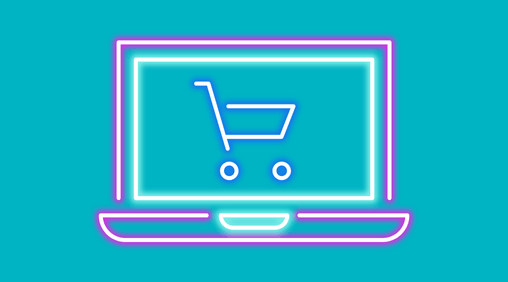Selling products online isn’t just an option anymore—for many businesses, it’s the most important growth engine. More and more people buy their items online, and this trend has accelerated in recent years more than ever.
For customers, online shopping means comparing conveniently, ordering quickly, and paying flexibly. For you as a merchant, it means enormous potential in reach, revenue, and access to new target groups.
Small and mid-sized businesses benefit in particular from how easy it has become to enter the online world. With the right tools, you can list your first products within hours—whether you want to sell handmade items, digital products, or an entire catalog. The barriers are low.
But successful online selling takes more than uploading a few product photos. You need a well-thought-out strategy, the right platform, and a professionally built shop. And don’t forget ongoing onlineshop optimization—from load speed to checkout.
In this article, you’ll learn step by step how to sell products online, from the idea and setup all the way to scaling.

Selling in-store or online?
If you want to market products, you’ll likely ask yourself: should I start offline or digital? The biggest advantage of selling online is reach. A physical store mainly attracts customers from your local area—online, you can reach millions of buyers nationally and internationally.
Another benefit: your business runs 24/7. Customers can order anytime, regardless of opening hours or holidays. For people with busy schedules, that convenience is a major reason to buy online.
You can also sell online without high fixed costs for rent, store setup, or staff like in brick-and-mortar retail. And it’s not just reach and cost—variety is another huge plus.
Especially popular are:
- Physical products: clothing, jewelry, electronics, home & living
- Digital products: e-books, online courses, software, music
- Print-on-demand: books, shirts, posters—customized per order
- Handmade: unique items and creative products via platforms like Etsy
Some audiences are easier to reach online than others. Younger consumers clearly prefer online buying, and older customers have increasingly built trust in online purchasing as well.
Physical stores do offer personal contact and immediate product experience, but digital selling lets you scale your brand much faster.
According to a study by the German E-Commerce and Mail Order Association (BEVH), revenue in German e-commerce reached €80.6 billion in 2024, an increase of 1.1% compared to the previous year. E-commerce maintained a share of around 10% of total retail—showing that digital business continues to grow steadily even in challenging times.
This doesn’t mean brick-and-mortar no longer matters—quite the opposite. Combining online and offline (omnichannel) is often the strongest strategy. If you’re starting with a limited budget, it’s frequently smarter to learn how to sell online before investing in a physical store.

Platform overview: marketplaces, shop systems, and social media
If you want to sell digitally, you can choose from multiple channels: large marketplaces, your own shop system, and social media platforms. Each option comes with its own pros, cons, and specifics.
Marketplaces: Amazon, eBay, Otto & Kaufland
Marketplaces are one of the fastest ways to market items digitally. Millions of potential buyers are active there every day, making it perfect for gaining reach and generating initial sales. Getting started is straightforward, as you don't need to set up your own store infrastructure.
Instead, you leverage the platform's existing reach, trust, and technical environment. This makes marketplaces particularly attractive for beginners who want to test their products and for retailers looking to reach new target audiences.
Amazon marketplace: products, reach & logistics advantages
Amazon is the world’s largest online marketplace and often the first stop for online shopping in German-speaking markets. Key benefits are massive reach, high customer trust, and services like FBA (Fulfillment by Amazon), where Amazon handles storage, shipping, and returns for you.
That lets you focus on your product business without managing the entire logistics chain.
- Best for: sellers who want to scale quickly, reach a broad audience, and benefit from Prime-related advantages. Amazon is especially attractive for products with high demand, solid margins, and a clear USP—e.g., electronics accessories, household items, or branded goods.
- Challenges: competition is intense, commissions and storage fees add up, and you’re heavily dependent on Amazon’s rules. Reviews and ranking algorithms often decide success or failure—if you’re not visible, you don’t sell.
For small niche products or very low-margin sellers, staying profitable can be difficult.
Conclusion: Amazon is ideal for products with strong sales potential and clear positioning. You benefit from reach and logistics, but you must withstand fierce competition—and you should never rely on Amazon as your only sales channel.
eBay: flexibility & auction-style selling
eBay is especially interesting for sellers of used, niche, or individual products. In addition to fixed-price listings, you can use auctions—great for collectibles, vintage items, or clearance inventory.
Best for: niche catalogs, used goods, and unique products. Also good for beginners who want early sales with low setup effort.
Challenges: eBay doesn’t have the same premium image as Amazon, and trust can be lower. Demand varies strongly by category, and reach can be limited in some segments.
Conclusion: eBay works well for niche products and flexible pricing models, but it’s less suitable for building a scalable brand strategy.
Otto.de: a strong player in Germany
Otto.de evolved from a classic mail-order business into a relevant e-commerce marketplace—especially strong in fashion, home/living, and tech. Sellers benefit from Otto’s brand trust and a loyal customer base that often prefers German providers.
- Best for: sellers in DACH offering high-quality products in Otto’s core categories, particularly brands focusing on quality and service.
- Challenges: access is more regulated than Amazon or eBay. Sellers must meet quality standards, and integration is more complex.
Conclusion: Otto is a good fit for quality-focused brands targeting German customers; it’s less ideal for quick testing or very broad catalogs.
Kaufland.de: growth & variety
Kaufland.de is growing rapidly and is attractive for sellers with broad catalogs—from electronics to groceries. A major advantage: Kaufland invests heavily in marketing and reach, so new sellers can gain visibility quickly.
- Best for: sellers with diverse assortments who want a relatively easy start—especially products that compete strongly on price and availability.
- Challenges: selling fees and increasing competition make differentiation harder. Sellers must stand out through service, quality, or value for money.
Conclusion: Kaufland.de is a fast-growing platform for quick visibility—but it shouldn’t be your only foundation. Long-term success depends on brand building.

Your own online shop: platform options at a glance
A standalone online shop is the “premier league” of e-commerce. Unlike marketplaces, you control prices, design, branding, and customer data. That makes you independent from third-party algorithms and rules—and gives you the chance to build a recognizable brand.
At the same time, it also means: you must generate your own traffic, keep an eye on the tech, and handle legal topics such as GDPR and withdrawal policies.
Shop systems can be roughly grouped into four categories:
|
category |
Systems |
Short description |
|
SaaS / Cloud |
Shopify (Standard), Shopify Plus, Shopify Advanced, BigCommerce (incl. Enterprise), Wix, Squarespace, Ecwid |
Hosted all-in-one solutions, quick start, easy to use, app integrations. Ideal for beginners and SMEs. |
|
Open Source |
WooCommerce, Magento (Adobe Commerce), Shopware, PrestaShop |
Self-hosted systems with high flexibility and adaptability, but more technical effort. |
|
Enterprise |
Shopify Plus, Commercetools, Scayle, NetSuite (Oracle), Zoey |
Scalable professional solutions for large retailers with complex processes and international markets. |
|
Close to the market square |
Etsy |
Platform for creatives, handmade products, and niche products. Easy entry, but limited control. |
Tip: We have already created detailed comparisons of individual systems.

Social commerce: Instagram, TikTok & Pinterest
Social commerce has become a true game-changer. Platforms like TikTok Shop, Instagram, and Pinterest Product Pins let you sell where your customers already spend their time. Entertainment and shopping merge—and that’s exactly why these channels work so well.
- Instagram (product tags & Reels): You can tag products directly in posts, Stories, or Reels and guide your community to checkout with minimal friction—often via your own shop. Instagram remains strong for visual categories like fashion, jewelry, and lifestyle.
- TikTok Shop: TikTok isn’t just a platform—it’s an entertainment app that connects trends, community, and shopping. Live selling, viral clips, and in-app purchases are creating a new generation of e-commerce. If you want to market products digitally, TikTok Shop should be a core part of your strategy.
- Pinterest Product Pins: Pinterest is a digital catalog for inspiration—interior, DIY, fashion, and more. Users often arrive with strong intent. Product Pins let you convert those moments of inspiration directly into sales.
Social commerce advantages are obvious: you’re close to your audience, can interact directly, and build real connection. You combine community, storytelling, and selling in one place—especially effective for visual, trend-driven products.
There are challenges too: you need to produce content consistently and track trends. And you depend heavily on algorithms—TikTok’s FYP or Instagram Explore can determine your reach.
Practical tip: Don’t run social commerce in isolation. Connect it to your own online shop to secure reach and valuable customer data for the long term.
Niche platforms: Etsy, Zalando & Idealo
Beyond the large marketplaces, specialized platforms can help you reach very specific audiences.
- Etsy (creative & handmade): Etsy is the most well-known platform for handmade products, vintage items, and creative goods—jewelry, art, personalized gifts, DIY kits, and more. Buyers often value individuality and are willing to pay more for special products.
- Zalando (fashion & accessories): Zalando is one of Europe’s biggest fashion platforms, with a very purchase-ready audience looking for clothing, shoes, and accessories. The advantage: Zalando is an established brand with high trust, known for professional service, clear returns, and fast delivery.
- Idealo (price comparison & reach): Idealo is less a marketplace and more a price comparison portal. Millions of users visit with strong purchase intent: they know what they want and look for the best price. If you can offer competitive pricing, you gain high visibility among buyers ready to convert.
Niche platforms can deliver a clearly defined target group with high intent—great for conversion. But they also come with challenges: smaller reach than Amazon/eBay, stricter requirements, platform dependency, and fees or rule changes that can limit visibility.
Practical tip: Use niche platforms strategically as an add-on to your main shop or marketplace strategy. They’re ideal for spotlighting specialized products and testing new audiences.

Successful shop examples: More Nutrition, ESN & OACE
Three brands, three industries—and one shared foundation: a strong business model combined with a professionally optimized e-commerce platform.
- More Nutrition: A German supplement company focused on functional products for mindful nutrition, aiming to enable “no-compromise diets.” The brand thrives on community and works closely with influencers, social media, and events.
- ESN (Elite Sports Nutrition): One of Germany’s leading sports nutrition brands, popular across Europe with products like Designer Whey and pre-workout boosters.
- OACE: A young German sportswear brand focused on innovative leggings, streetwear, and activewear—combining performance and lifestyle with clear positioning via design and comfort.
All three brands use Shopify as their technical foundation—for flexibility, scalability, and fast iteration. This is where Datora comes in: we optimized the shops of More Nutrition, ESN, and OACE technically, built custom features, and supported the migration to Shopify 2.0. We also manage and coordinate product launches and campaigns.
With the right strategy and technical setup, your shop can become the next success story. At Datora, we develop custom Shopify Plus solutions and take your online shop to the next level.
Strategy & preparation: your first steps before selling
- Market analysis & target audience:
Before offering products, understand your market and audience. Use tools like Google Trends or Keyword Planner to assess trends and search volume. Define customer needs and how your product solves them better than competitors. - Product choice & assortment:
Not every product performs equally well online. Bestsellers are often fashion, beauty, or electronics—but niche products can also have huge potential. Key factors: demand, quality, margins, and a clear USP. - Branding & storytelling:
Products are interchangeable; brands create loyalty. Tell an authentic story, communicate values, and show what you stand for. Strong storytelling across website, social media, and packaging builds trust and turns buyers into repeat customers. - Pricing & margins:
Solid calculations are essential for profitable online selling. Consider cost of goods, shipping, platform fees, marketing, and taxes to set realistic prices. Test models—often a higher price paired with strong branding works better than competing purely on price.
Execution & growth: from launch to scaling
- Build & optimize your shop: Your online shop is the base. A clear domain, mobile-optimized design, and simple navigation are essential. Build trust with reviews, badges, and transparent delivery times. Use A/B tests and conversion-rate best practices to improve performance. Don’t forget legal basics like imprint and privacy policy.
- Logistics & shipping: Customers expect fast, transparent delivery. Decide whether to ship yourself or use fulfillment. Clear communication about shipping costs and delivery times reduces abandonment.
- Marketing & reach: SEO creates sustainable traffic; social media increases visibility; ads deliver quick results. Retargeting brings back hesitant buyers. CRO services for Shopify Plus can help optimize conversion even further.
- Growth & scaling: Once your shop is running, the next stage is growth. Automation makes operations more efficient and reduces errors. Multichannel strategies open new sales channels. Internationalization expands into new markets. Future topics like AI, personalization, and sustainability help ensure long-term success.
A successful online shop needs more than products—it relies on structure, trust, and clear processes. An optimized shop, transparent logistics, and smart marketing create the foundation.
Scaling works through automation, multichannel strategies, and internationalization. Add trends like AI, personalization, and sustainability—and your shop becomes not just successful, but future-ready.

Conclusion: selling products online
Online commerce offers huge opportunities—from reach and revenue to international growth. But success in e-commerce doesn’t happen by accident: it requires a clear strategy, the right platform, and a shop that’s conversion-optimized, technically stable, and customer-focused.
Whether you sell via large marketplaces like Amazon and eBay, specialized niche platforms, or your own Shopify shop, what matters most is that your sales model fits your products and your audience.
Social commerce on TikTok or Instagram adds another powerful layer—letting you present your brand authentically and meet customers where they already spend time.
Real-world results show: successful brands like More Nutrition, ESN, or OACE rely on professional e-commerce solutions built for growth and scaling. And that’s the key—only those who control processes, technology, and marketing can stay profitable over the long term.
If you want to market your products digitally, start with a clear plan—and keep optimizing your shop continuously. With the right preparation and the right partners, your online shop can become a long-term success story too.
If you want to compare e-commerce platforms, you might also be interested in these topics:.








